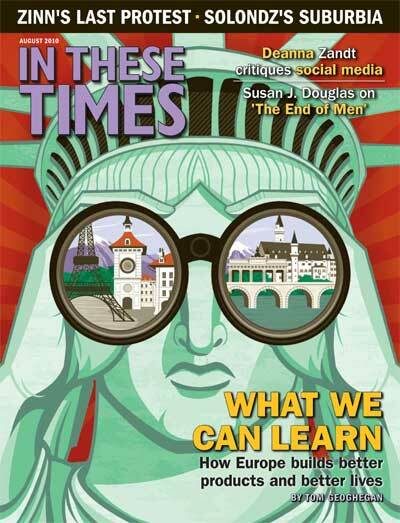Slavery in Our Time
For the first time, the U.S. government acknowledges modern-day slavery in the United States.
Michelle Chen

One-hundred-and-fifty years after the abolition of slavery, the State Department has acknowledged that people in the United States continue to be bought and sold as property.
The department’s 2010 “Trafficking in Persons” (TIP) report, a global review of human trafficking and civic and legal responses to it, lists the United States for the first time among the nations that harbor modern-day slavery.
The report was a long time in coming. In 2001, when Washington was rolling out landmark anti-trafficking legislation, Maria, a Mexican woman, testified before the House Committee on International Relations on her experience with sex slavery in Florida. “If any of the girls refused to be with a customer, we were beaten. If we adamantly refused, the bosses would show us a lesson by raping us brutally. We worked six days a week, twelve hours a day. Our bodies were sore and swollen. If anyone became pregnant we were forced to have abortions. The cost of the abortion was added to the smuggling debt,” she said.
The report gives the United States high marks for its efforts to combat trafficking, but victims remain scattered throughout the workforce, hidden from view: the captive migrant tomato picker, the prostitute bonded by a smuggling debt, the domestic servant working without pay.
The media often focus on stories of young girls lured into prostitution rings. But government data suggest that “more foreign victims are found in labor trafficking than sex trafficking,” particularly in “above ground” sectors like hotel work and home healthcare. Estimates vary, but the number of victims worldwide could be more than 12 million children and adults.
Today’s slave trade capitalizes on vast inequalities, sharpened by economic globalization, that spur migration across national borders. Many governments have instituted anti-trafficking policies, but with uneven success. The TIP report states that 23 countries got an “upgrade” in the ranking of their anti-trafficking programs. But 19 countries were “downgraded” due to “sparse victim protections, desultory implementation, or inadequate legal structures.”
Despite the country’s relative wealth and sophisticated legal system, slavery trickles into the United States through deep cracks in labor and immigration laws.
Victims often remain hidden because they depend on their bosses not only for their livelihoods but for protection from immigration authorities. Even for documented workers, legal status is not a safeguard, and precarious temporary worker visas may even facilitate trafficking.
Stephanie Richard, director of policy with the Los Angeles-based Coalition to Abolish Slavery and Trafficking (CAST), told In These Times: “We’re actually seeing an increase in the number of cases of people coming in on lawful visas, and then ending up in human trafficking … because people are using those visas as one of the forms of coercion for keeping people working for them against their will.”
To its credit, the State Department’s report stresses that anti-trafficking measures should not just emphasize cracking down on trafficking crimes, and that a comprehensive “victim-centered” approach should “focus on all victims, offering them the opportunity to access shelter, comprehensive services, and in certain cases, immigration relief.”
To qualify for special immigration relief-the T visa-trafficking survivors must cooperate with law enforcement investigations – a process advocates say can be humiliating and traumatic. That may be why the number of T visas granted each year is far smaller than the estimated number of survivors. And despite pressure to bring survivors into the criminal process, the Department of Justice’s Human Trafficking Prosecution Unit reported only 47 convictions in 43 human trafficking prosecutions in fiscal year 2009.
This year’s report glosses over the systemic failures that fuel the thirst for cheap labor – or even free labor. Sienna Baskin, an attorney with the Sex Workers Project – which campaigns for legislation to protect the rights of trafficked sex workers in New York – sees a correlation between the trafficking epidemic and immigration and law enforcement policies that criminalize victims. Baskin told In These Times, “The growing problem of labor exploitation could be lessened by comprehensive immigration reform that provides visas and fair wages to all workers.”
The Florida-based Coalition of Immokalee Workers merges anti-trafficking, immigration reform and labor activism in its campaigns for farm workers’ rights. The group was recently honored by the White House for its Campaign for Fair Food, which has successfully pressured corporations to adjust their labor policies across the supply chain, from the tomato farms all the way up to restaurants like Taco Bell.
At the D.C. event announcing the new TIP report, Laura Germino, coordinator of the Coalition’s Anti-Slavery Campaign, said that 20 years ago the United States refused to acknowledge “that the unbroken threat of slavery that has so tragically woven through our history … was a constant.” She added, “But here’s the good part. There was nowhere to go but up.”
This article originally appeared in different form on In These Times’ workers’ rights blog, Working In These Times.
Michelle Chen is a contributing writer at In These Times and The Nation, a contributing editor at Dissent and a co-producer of the “Belabored” podcast. She studies history at the CUNY Graduate Center. She tweets at @meeshellchen.









